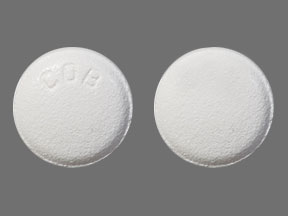Cobimetinib Disease Interactions
There are 7 disease interactions with cobimetinib.
- Cardiomyopathy
- Hepatotoxicity
- Ocular toxicities
- Rhabdomyolysis
- Lung toxicity
- Liver dysfunction
- Renal impairment
Cobimetinib (applies to cobimetinib) cardiomyopathy
Moderate Potential Hazard, Moderate plausibility.
Cardiomyopathy, defined as symptomatic and asymptomatic decline in left ventricular ejection fraction (LVEF), can occur with the use of cobimetinib. Evaluate LVEF prior to, 1 month after initiation, and every 3 months thereafter until discontinuation of cobimetinib. It is recommended to manage events of left ventricular dysfunction through treatment interruption, dose reduction, or discontinuation of therapy. If restarting cobimetinib after a dose reduction or interruption it is recommended to evaluate LVEF as clinically indicated. Care should be exercised when using cobimetinib as the safety of cobimetinib has not been established in patients with a baseline LVEF that is either below institutional lower limit of normal (LLN) or below 50%.
Cobimetinib (applies to cobimetinib) hepatotoxicity
Moderate Potential Hazard, Moderate plausibility. Applicable conditions: Liver Disease
Hepatotoxicity can occur with the use of cobimetinib. It is recommended to monitor liver function tests before initiation of therapy, monthly during treatment, or more frequently as clinically indicated. Manage Grade 3 and 4 liver laboratory abnormalities with dose interruption, reduction, or discontinuation of therapy. Close monitoring is recommended.
Cobimetinib (applies to cobimetinib) ocular toxicities
Moderate Potential Hazard, Moderate plausibility. Applicable conditions: Visual Defect/Disturbance
Ocular toxicities can occur with cobimetinib, including serous retinopathy. Consider ophthalmologic examinations including retinal evaluation before treatment and at regular intervals during, and any time a patient reports new or worsening visual disturbances. If serous retinopathy is diagnosed, interrupt treatment with cobimetinib until visual symptoms improve. Manage serous retinopathy with treatment interruption, dose reduction, or with treatment discontinuation. Close monitoring is recommended.
Cobimetinib (applies to cobimetinib) rhabdomyolysis
Moderate Potential Hazard, Moderate plausibility. Applicable conditions: Myopathy
Rhabdomyolysis can occur with the use of cobimetinib. It is recommended to obtain baseline serum creatine phosphokinase (CPK) and creatinine levels prior to initiating therapy with cobimetinib and periodically during treatment as clinically indicated. If CPK is elevated, evaluate for signs and symptoms of rhabdomyolysis or other causes. Depending on the severity of symptoms or CPK elevation, dose interruption or discontinuation may be required. Care should be taken when using this agent in patients at risk for rhabdomyolysis.
Multikinase inhibitors (applies to cobimetinib) lung toxicity
Moderate Potential Hazard, Moderate plausibility. Applicable conditions: Interstitial Pneumonitis, Pulmonary Impairment
The use of certain multikinase inhibitors has been associated with pulmonary toxicity. Serious cases of interstitial lung disease (ILD), including fatal cases and interstitial pneumonitis or pulmonary fibrosis have been reported. Caution is recommended when using these agents in patients with a history of interstitial pneumonitis or pulmonary fibrosis or those patients presenting with acute onset of new or progressive unexplained pulmonary symptoms such as dyspnea, cough, and fever pending diagnostic evaluation. If ILD is confirmed, these agents should be permanently discontinued and appropriate measures should be instituted. Treatment should be immediately withheld in patients diagnosed with ILD/pneumonitis and permanently discontinued if no other potential causes of ILD/pneumonitis have been identified.
Olutasidenib (applies to cobimetinib) liver dysfunction
Moderate Potential Hazard, Moderate plausibility. Applicable conditions: Liver Disease
The recommended dosage of olutasidenib has not been established in patients with severe hepatic impairment. Additionally, this drug can cause hepatotoxicity with elevated alanine transaminase (ALT), aspartate aminotransferase (AST), blood alkaline phosphatase and blood bilirubin being the most common findings. Use with caution and monitor patients frequently for signs and symptoms of hepatotoxicity and liver impairment during treatment.
Olutasidenib (applies to cobimetinib) renal impairment
Moderate Potential Hazard, Moderate plausibility. Applicable conditions: Renal Dysfunction
The recommended dosage of olutasidenib has not been established in patients with severe renal impairment (CrCl 15 to 29 mL/min), kidney failure, and patients on dialysis. Caution is advised.
Switch to professional interaction data
Cobimetinib drug interactions
There are 406 drug interactions with cobimetinib.
Cobimetinib alcohol/food interactions
There is 1 alcohol/food interaction with cobimetinib.
More about cobimetinib
- cobimetinib consumer information
- Check interactions
- Compare alternatives
- Side effects
- Dosage information
- During pregnancy
- Drug class: multikinase inhibitors
- Breastfeeding
- En español
Related treatment guides
Drug Interaction Classification
| Highly clinically significant. Avoid combinations; the risk of the interaction outweighs the benefit. | |
| Moderately clinically significant. Usually avoid combinations; use it only under special circumstances. | |
| Minimally clinically significant. Minimize risk; assess risk and consider an alternative drug, take steps to circumvent the interaction risk and/or institute a monitoring plan. | |
| No interaction information available. |
See also:
Further information
Always consult your healthcare provider to ensure the information displayed on this page applies to your personal circumstances.


